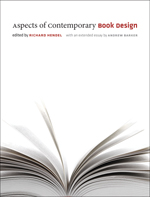Aspects of Contemporary Book Design
“Richard Hendel follows On Book Design with another fresh and incredibly informative book focusing on the book design process and philosophies of leading contemporary designers. The book's range is impressive. Essays are clear in the issues designers confront while working with different kinds of manuscript material and thoroughly address budget, marketing, and editorial considerations that might affect a book's design. Interspersed is a brief history of type and bookmaking, along with many specific illustrations to clarify and illuminate the text. Because technology is changing so rapidly, this book is an invaluable resource for either novice or professional designer, helping each navigate and shape design challenges and choices in the making of books, from print to digital.”—Anita Walker Scott, retired design and production manager, Johns Hopkins University Press
“In Aspects of Contemporary Book Design, Rich Hendel interviews a number of leading book designers who tell all and show all. The result is a wonderful and inspiring compendium of current book design. Whether you are a student or a professional, you will glean valuable insights to the world of type and book design. Sharply observed, these words are worthy of many readings.”—Tony Crouch, retired director of design and production, University of California Press
“Rich Hendel begins Aspects of Contemporary Book Design by floating the proposition that, ‘these may be the final days of book design.’ Don’t believe him. For he then proceeds to prove himself wrong, chapter after chapter. Throughout this learned and insightful series of interviews, Hendel and his fellow designers both reaffirm and celebrate the enduring role played by design in uniting the ideas of authors with the enthusiasms of readers. Along the way we enjoy stories and lessons served up by some of the best designers in publishing. The result is a great tour of the very lively art of book design.”—Peter Dougherty, director, Princeton University Press
In this manifestly practical book, Richard Hendel has invited book and journal designers he admires to describe how they approach and practice the craft of book design. Designers with interesting and varied careers in the field, who work with contemporary technology in today’s publishing environment, describe their methods of managing the challenges presented by specific types of books, presented side by side with numerous images from those books. Not an instruction manual but a unique, on-the-job, title page–to–index guide to the ways that professional British and American designers think about design, Aspects of Contemporary Book Design continues the conversation that began with Hendel’s 1998 classic, On Book Design.
Contributing designers who focus on solving problems posed by nonfiction, fiction, cookbooks, plays, poetry, illustrated books, and journals include Cherie Westmoreland, Amy Ruth Buchanan, Mindy Basinger Hill, Nola Burger, Ron Costley, Kristina Kachele, Barbara Wiedemann, and Sue Hall, as well as a host of other designers, typesetters, editors, and even an author.Abbey Gaterud attempts to define the conundrum that the e-book presents to designers; Kent Lew describes the evolution of his Whitman typeface family; Charles Ellertson reflects upon the vital relationship between the typesetter and the designer; and Sean Magee writes about the uneasy alliance between designers and editors. In an extended essay that is as frank and funny as it is illuminating, Andrew Barker takes the reader deep into the morass—excavating the fine, finer, and finest details of working through a series design.
At the heart of this copiously illustrated book is the enduring need for design that clarifies the way for the reader, whether on the printed page or on the computer screen. Blending his roles as designer, author, interviewer, and editor, Hendel reaches across both sides of the drafting table—both real and virtual—to create a book that will appeal to aspiring and seasoned book designers as well as writers, editors, and readers who want to know more about the visual presentation of the written word.



